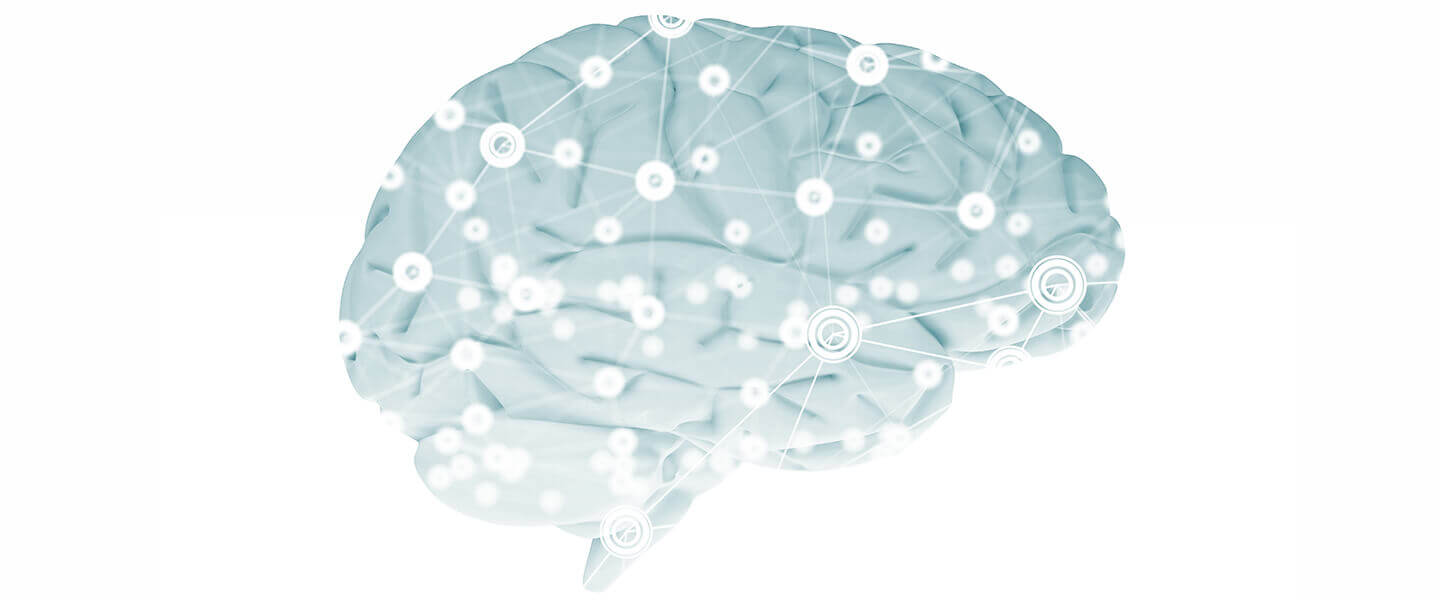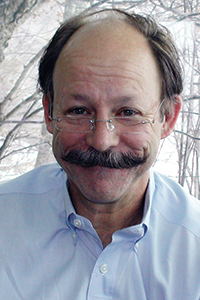Pioneering TMS Therapy for Depression
Pioneering TMS Therapy for Depression

Luck, Hard Work...and Crucially Timed BBRF Grants
There is a moment in the career of Mark S. George, M.D., that he thinks of as lucky. It changed the course of his life and—though he could not have known it then—the lives of thousands of seriously depressed people.
It was 1989. A young physician-scientist then studying in London, Dr. George happened to be in a hospital elevator when a man, evidently a patient, turned to him and said: “Hey doc, a man just put a magnet over my head and made my thumb twitch!”
George remembers: “As he got off the elevator, I asked him: ‘What floor?’ He said ‘Eight,’ so I punched that button.” George found himself in the laboratory of a scientist who was in possession of one of the few machines in the world designed to deliver magnetic stimulation to the brain non-invasively, via the scalp. Called transcranial magnetic stimulation, or TMS, it was invented only 4 years before, and it was a subject of curiosity.
It was known at the time that TMS could make a finger move, by gently applying stimulation just above a motor area of the brain. That’s why it excited Dr. George. This made him wonder if there was a way TMS could be directed so that it affected areas of the brain involved in causing depression.
For decades, a technology called ECT (electroconvulsive therapy) had been used to deliver electromagnetic waves into the brain to alleviate difficult-to-treat major depression. ECT was used when other forms of therapy failed. It could be administered only after a patient had been placed under anesthesia. It was powerful, and induced a seizure that was designed to be therapeutic. ECT was sometimes accompanied by cognitive side effects, most notably memory loss. Some people with major depression literally could not live without it, but others were either not helped or were not willing to risk the side effects.
TMS, as Dr. George quickly learned, was very different. The idea behind it was that a much less intense series of magnetic pulses, delivered into the outermost layer of the brain just beneath the skin, might induce electrical activity that would therapeutically alter neural connections in brain areas involved in depression. If such an approach worked, it would mean that brain-stimulating therapy could be delivered to patients who were wide awake and who would not have to endure a seizure to experience a reduction in symptoms.
These ideas were plausible to young Dr. George because, in his words, “I have had a life-long research interest of figuring out the road map of where depression lives in the brain.” It was indeed “lucky,” as he modestly says, that in the late 1980s he walked into one of the few rooms in the world housing a TMS machine. But rather than a story of pure luck, his story may more accurately demonstrate the truth of Louis Pasteur’s famous observation that “chance favors the prepared mind.”
When Dr. George fatefully met that patient in the elevator, “we were just starting to think about circuits in the brain—and it had been proposed that you might be able to stimulate the cortex [just beneath the scalp] and it would affect circuits that led to areas much deeper in the brain.” Knowing that non-invasive stimulation could alter circuits affecting motor and sensory systems, he now hoped that it would also work in circuits that regulated human emotions.
The path between that moment nearly 30 years ago and today has been anything but easy. Today, TMS in various forms is widely used and approved by the U.S. Food and Drug Administration for treatment of depression, epilepsy, and obsessive-compulsive disorder. And its use is being tested in a variety of other disorders including PTSD, Parkinson’s, and anxiety. It may prove to be a way to control pain and even to manage obesity.
Dr. George had two very important bits of good fortune in the early stages of the journey. One was getting the go-ahead from Dr. Robert Post, with whom he worked at his next career stop, the National Institutes of Health, to test TMS as a non-invasive treatment for mood disorders. Dr. Post, who served for 20 years as the Chief of the Biological Psychiatry Branch at the NIH, is also a member of BBRF’s Scientific Council, and for many years has chaired the annual assessment of BBRF Independent Investigator grant applications. Dr. George recalls that because of Dr. Post’s openness to new ideas, “We were able to do the first safety studies, with healthy subjects, and were able to get an idea from that research of the effects of TMS on the brain.”
Though Dr. George was extremely excited that a new era of non-invasive therapy might be dawning, especially after publishing peer-reviewed safety data on TMS, it was not long before he ran into a brick wall. The early 1990s was the moment of the “Prozac Revolution” in the United States, in which antidepressant medicines such as Prozac, Paxil, Celexa and others like them were first widely prescribed. All belonging to the class of SSRIs, or selective serotonin reuptake inhibitors, these oral medicines acted to sustain levels of the neurotransmitter serotonin in the synapses, or gaps, between brain cells, and in that way, it was thought, facilitated brain-cell communication, elevating mood.
At that time, transcranial magnetic stimulation therapy frankly seemed a bad idea to the scientific director of the intramural program at the National Institute of Mental Health. Dr. George was advised to not discuss his research for fear of “sullying the name of the NIH,” he remembers, and his lab was closed. He moved to the faculty of the Medical University of South Carolina, where he has been ever since—now a Distinguished Professor of Psychiatry, Radiology and Neuroscience. He was first charged with building a center for functional MRI (fMRI) brain imaging, another of his specialties. This was another technology that would prove to have a very bright future. It was less controversial than TMS.
Dr. George continued to appeal to NIH for grants to continue his TMS work, without success. It was around that time that he experienced another stroke of good fortune. “With the NIH not receptive,” he remembers, “I wrote a grant application to NARSAD”—the organization that is now the BBRF.
“With that first NARSAD Young Investigator award in 1996, I was able to acquire a TMS machine that my supervisor in South Carolina had authorized. I immediately began to plan a whole series of clinical studies to further test and improve the technology. Eventually, a private company was formed by others that patented a particular form of TMS technology. But in the 10 years when there was no NIH funding and before there was a TMS industry, there was BBRF—two grants in succession that kept the thread going.
“The point I hope you can get across to donors and readers,” Dr. George stresses, “is that without BBRF’s support during that really critical time, I don’t think we’d have the TMS technology that is currently available and that is now being applied beyond depression in other illnesses. That’s why I’m forever grateful.
“I believe in the mission of BBRF because it was their support that enabled us—as intended—to figure out all of the things you have to have in hand before you can do a large clinical trial with a new technology.”
An industry-sponsored multicenter, randomized controlled clinical trial (RCT) involving 300 patients was indeed carried out, which Dr. George helped design and carry out. Demonstrating the safety and effectiveness of TMS in the acute treatment of depressed patients who had not responded to prior antidepressant treatments, the trial, whose results were published in 2007, helped persuade the FDA to approve TMS the following year, establishing as standards the treatment protocols used in the trial. In 2010, Dr. George and colleagues published the results of an NIH-sponsored RCT which confirmed those results and established TMS as a proven therapy.
The approval at that time was specifically for the treatment of treatment-refractory depression. Among the class of treatment-resistant patients are those with life-threatening depression who traditionally have had to turn to ECT for lack of another option. While ECT remains an important option today, TMS now provides an option that is available to all people with depression. In addition to being more convenient than ECT, it is much safer. Apart from transient headache, treatable with aspirin, TMS is generally free of side effects, according to Dr. George.
He says that he is proud that the technology and procedures used today are actually superior to those he and colleagues devised years ago. Those procedures, developed with grant support, marked a truly novel approach to depression. They broke through the institutional resistance that had slowed its adoption and earned for TMS the government’s stamp of approval.
— Written By Peter Tarr
Click here to read the Brain & Behavior Magazine's March 2019 issue



